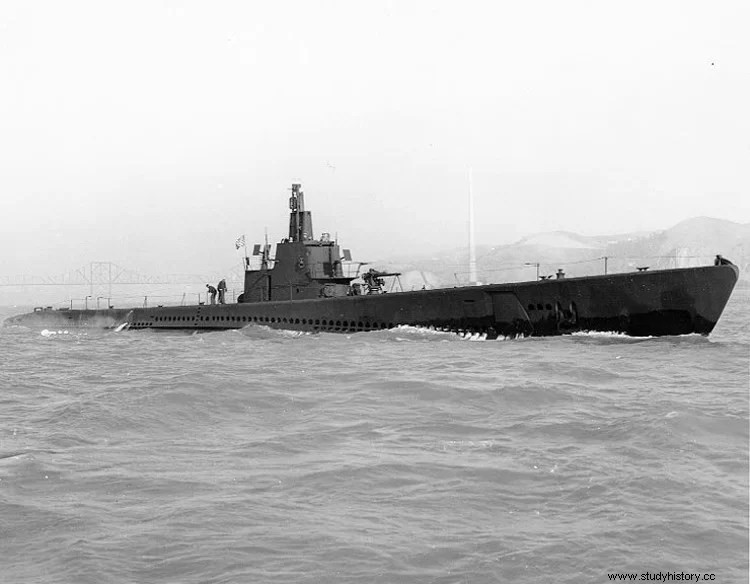There are a few myths that revolve around a character or several condemned to do something eternally. It doesn't take much memory to bring to mind Sisyphus and the huge rock that Zeus forced him to push to the top of a hill, rolling down the slope at the last moment and having to start over and over again. . Or the legend of the Flying Dutchman , the ship that was to wander the seas forever without ever touching land as divine punishment for having made a pact with the devil not to be shipwrecked. The one with the Dutch It comes in handy for this article, since it turns out that in the US Navy some submarines spend their entire lives on patrol without returning to port. Let's see how it's possible.
First of all, it is necessary to clarify that there is a fundamental difference with the myths outlined above:in this case it is not a curse or an implacable sentence, but quite the opposite; a nice way to honor the memory of the crews. Memory, yes, because it actually refers to the submarines that never returned from their missions but whose fate is unknown.
It is evident that they will be resting eternally at the bottom of the sea after being sunk by the enemy, or else they suffered some kind of accident that brought them a tragic end. But since it is not known, the original custom of considering them Still on patrol was adopted. , that is, "Still on patrol".

Active duty sailors would never even consider leaving their comrades behind. It is a common idea in the armed forces not to abandon anyone on the battlefield, among other reasons because it is considered humiliating for the unit. In fact, during maneuvers and training, retreat is practiced in which some carry others on their backs as if they were wounded. The problem is that this is impossible at sea, especially if we talk about submarines, ships that normally operate alone - not for nothing are they nicknamed lone wolves – and they often have to keep quiet so as not to give away their position.
Another thing is the submarines that sink in localized places, for which cumbersome rescues are organized, sometimes successfully and sometimes not. Two cases that occurred in the US Navy are famous. One took place in 1927, when the S-4 sank off Cape Cod after colliding with a Coast Guard destroyer near Massachusetts and inside which several sailors survived for three days at the bottom without anyone being able to get them out.
The other, in 1939, was that of the USS Squalus , which flooded in New Hampshire during the test dive and was immobilized in a depth of 74 meters, although 33 of the 59 crew members were rescued. But both were near the coast and in peacetime; the warlike circumstances totally change the situation.

Therefore, those submersibles that disappear without a trace receive the aforementioned consideration of Still on patrol and every year, when the Christmas holidays arrive, the communications partners on land send the corresponding congratulations by radio, although they know that these waves will never be heard by their recipients. Sometimes, after years or decades, the wreck where some of them rest is located and the submarine then changes category.
The same goes, by the way, for fighter jets. Although these are usually easier to find, sometimes there are those that disappear forever. For example, the five TBM Avenger bombers whose trail was lost when they flew over the Caribbean in the middle of a storm in 1945. The case was popularly attributed to the famous -and refuted- Bermuda Triangle, although the technical reports conclude that the commander became disoriented in the middle of the storm and guided the others offshore until they ran out of fuel; officially, they follow Still on patrol .

Returning to submarines, they are the ones with the highest number of losses and the list is impressive, which includes those sunk in action against the enemy, those hit by friendly fire (or even their own), those that were shipwrecked by collision, those that suffered marine shocks or those that ran aground by accident.
During the First World War, two sinkings were recorded and in the interwar period, nine. In World War II the figure rose dramatically to 52, so that weapon was the one with the highest percentage of casualties, one in five sailors. After that contest, another four were added.
It is worth adding, as a curiosity, the two before the 20th century:in 1776 the Turtle , sunk in New Jersey, during the revolution, when trying to attack a British ship; and in 1862 the Alligator , which sank when it was towed in the middle of a storm in the middle of the Civil War. The H.L. Hunley , which disappeared in 1865 after destroying a Union ship -the first in history to be the victim of a submarine- but the wreck was found in 2000.

Those who are still "on patrol" are several and all in the context of the Pacific campaign, fighting against the Japanese. Of course, it must be taken into account that the lists vary according to the criteria applied, since some include those who are suspected of being the cause of their disappearance, while others are limited only to those who disappeared without further ado, the hypothesis being more likely for this to have run into a mine or been rammed.

In any case, it can be said that those of completely uncertain destiny are the following:Capelin (lost in the Celebes Sea), School (in the Yellow Sea), Grayling (in the Philippine Gulf of Lingayen), Growler (in the Philippines), Gudgeon (on Iwo Jima), Kete (in the Japanese Ryukyu Islands), Pompano (in Honshu), R-12 (in Key West, Florida), Runner (in Hokkaido), Scorpion (in the East China Sea), Shark (Moluccan Sea), Snook (in the South China Sea) and Swordfish (in the Ryukyu Islands). In fact, there are more that could be included, as can be seen on the plaque in the attached photograph, which is in the Independence Seaport Museum in Philadelphia.
That monument will have to be retouched because two names can already be removed. In 2019 the wreck of the USS Robalo was located near Balabac Island; Interestingly, four of her crew survived but died in captivity without her condition being known. In November of that same year, the remains of the USS Grayback were also found. off Okinawa. The others follow still on patrol , posthumously fulfilling her duty.
